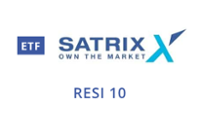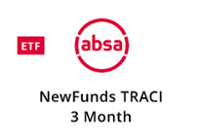Diversify your portfolio with ETFs
Intellidex ETF Picks
Diversification is still the key narrative for INVSTRs trying to navigate global economic uncertainty as this week’s Intellidex Exchange Traded Funds (ETFs) picks clearly shows.
The investment environment
Progress in vaccinating populations worldwide remains key to the global economic recovery. This is especially the case as new virus variants and high infection rates pose an ongoing risk.
According to Bloomberg’s vaccine tracker, 2.15-billion shots were administered worldwide by 7 June. As expected, developed countries continue to lead the way in both vaccinations and economic recovery – 27.5% of the vaccination doses were administered to a mere 27 out of 176 countries.
South Africa is experiencing its third wave of infections, with President Cyril Ramaphosa announcing adjusted level two restrictions in late May. The measures are largely focused on curbing social mobility and should not have a significant effect on the economy. In this regard, the hospitality and liquor industries, which have been most affected by restrictions, welcomed the fact that there are no additional limitations on the sale of alcohol.
However, the risk of the third wave is more severe due to the winter season increases the urgency of handling infections. This is especially the case as crippling load-shedding returned to haunt the economy and is a genuine risk to Q2 2021 real GDP growth. On a positive note, the University of Stellenbosch’s Bureau of Economic Research reports that SA’s weekly vaccination rate has increased but is expected to remain limited to 75,000 shots a week unless the Johnson & Johnson vaccine doses are delivered as scheduled. They are delayed, however, due to a manufacturing concern under investigation by the US Food & Drug Administration.
Economically, data releases pointed to a mixed start to Q2 2021 for SA. According to the Automotive Business Council, new vehicle sales came in at 35,779 units in May, far higher than the 12,874 vehicles sold during part of the lockdown in the same month of last year. However, the key takeout from the report is that SA’s structural issues remain a hurdle to new vehicle sales returning to pre-pandemic levels.
Purchasing Managers’ Index (PMI) data, which indicate the prevailing direction of economic trends (a level above 50 points to an improvement in the economy), slowed down in SA. Absa’s manufacturing PMI slowed to 56.2 in April from 57.4 in March after three months of improvement. However, an analysis of the components underlying the survey showed that all subcomponents were in positive territory.
SA’s retail trade sales were down 2.5% yearly in March, with general dealers (-9.3%) contributing the most to the decline in sales, as reported by Statistics SA. The decline in retail trade sales points to a possible peak in pent-up demand within the retail sector as extra income payments to citizens (grants and various payouts from 2020) came to an end. This, combined with possible caution in consumer behaviour due to the third wave, poses a risk to the retail sector outlook for SA in the rest of 2021.
Inflation (reported by Stats SA) in SA rose to 4.4% annually in April from 3.2% in March. The increase was driven by higher food and non-alcoholic beverage prices as well as transport prices. The Reserve Bank kept the repurchase rate unchanged at 3.5%, which was largely in line with market consensus.
While the bank is not too concerned about SA’s inflation outlook, investors are nervous about recent price trends globally. SA’s export growth has outpaced import growth since the reopening of the economy. Exports have been driven by global commodity demand. However, should import demand recover and oil prices remain firm, then the risk of rising inflation in SA may put upward pressure on local interest rates.
Globally, the recovery was stalled by fears of high inflation and the possibility of interest rates increasing sooner than expected. The core personal consumption expenditure (PCE) index, which is the US Federal Reserve’s (Fed) preferred inflation measure, rose 3.1% annually in April – well above the Fed’s 2% target. The prospect of rising inflation increases the likelihood of higher interest rates, which would send equity markets lower. In addition, the most recent inflation trends spooked markets, despite major central banks emphasising that current inflation trends are transitory rather than permanent.
Indeed, the argument that inflation trends are transitory might hold when analysing the US labour market. According to the US Bureau of Labour Statistics, the US economy added 559,000 jobs in May, which was below market expectations of 650,000. This is a somewhat better performance than in April, when reported job numbers underwhelmed even more. With the US economy still having 7.6-million jobs less than pre-pandemic levels, current inflation trends may actually be transitory rather than structural.
The eurozone is in a technical recession as real GDP shrank 0.6% quarterly in March, following a 0.7% quarterly decline in Q4 2020. However, manufacturing PMI data showed light at the end of the tunnel. The index inched up to 62.9 in April from 62.5 in March. Growth was broad-based, with gains in investment and intermediary goods.
In the UK, economic growth contracted 1.5% quarterly in Q1 2021 after a 1.3% quarterly increase in Q4 2020. However, the initial momentum from reopening the economy and rapid vaccination reflects in the UK economy’s composite PMI which increased to 62 points in May from 60.7 in April. It was boosted by pent-up demand in manufacturing and services.
China’s economy grew 18.3% annually in Q1 2021, underpinned by continued measures to curb the pandemic and a strong economic recovery. The Asian giant’s export-led growth should moderate further during this year though, as other economies reopen, and countries demand less pandemic-related and work-from-home products. Moreover, trade and geopolitical tensions may dampen growth in China for the rest of this year, with upside linked to stronger-than-expected domestic demand.
The Intellidex favourite ETFs:
Domestic equity:
Further signs of continued price pressure could lead to increased volatility, especially in the US where equity prices are at elevated levels. In emerging markets and SA, there may be spillover effects as the risk of higher interest rates in the US increases the prospect of higher rates in emerging markets. Emerging markets would have to increase interest rates to avoid currency depreciation and falling asset prices due to capital moving out to developed markets.
Consequently, we retain the NewFunds Low Volatility Equity ETF (+3.1% in May) from last month’s publication. It should help investors to deal with volatility against a backdrop where the market grapples with data on the global economic recovery being offset by inflation fears.
Satrix RESI: We also retain the Satrix RESI (-1.7%), which provides investors with exposure to the ongoing momentum in commodity demand and prices. Over the medium term, commodity demand may be boosted by trends in renewable energy, which is positive for platinum group metals (PGMs). In this regard, SA miner Sibanye Stillwater is committed to investing R6.3bn in three new projects.
Ashburton Midcap: This ETF (+5.9%) provides exposure to the mid-cap section of the JSE. It trades just below pre-pandemic levels when compared to large-cap ETFs. It can position investors for any upside in the second half of this year, especially if global sentiment improves and SA manages to gain economic momentum from controlling the third wave of infections and progress on vaccination. The fund is pricey though, with a total expense ratio (TER) of 0.61%.
Foreign equity:
Bloomberg projects that assets under management (AUM) linked to environmental, social and governance (ESG) investments should reach $53tn by 2025. This figure should be a third of global AUM which is expected at $141tn in the same year. In addition, Bloomberg expects inflows into ESG ETFs to surpass $135bn before the end of 2021, with $5 trillion worth of inflows expected over the next five years. The pandemic and a green recovery in the US, EU and China are the medium to long term drivers underpinning the projections related to ESG investing.
Moreover, the Boston Consulting Group expects passive assets under management to grow 6% annually to $25trn by 2024, highlighting the increased prominence passive investing will play in ESG investments. As a result, we retain our Sygnia Itrix S&P Global 1200 ESG ETF (-4.0%) pick.
As discussed in the domestic equity section, emerging markets are exposed to the volatility fuelled by inflation fears in their developed market counterparts. However, inflation trends confirming that price increases are temporary, rather than permanent may spark a renewed “risk-on” sentiment.
This, combined with a significant reduction in infection rates and progress on vaccination may lead to upside potential in emerging markets. Investors can use the Satrix MSCI Emerging Markets ETF (-2.9%) to gain broad exposure to emerging markets (TER: 0.40%), including China, which has the best prospects of all emerging markets in 2021.
Bonds and Cash funds:
We still hold the view that a pre-emptive allocation to inflation-linked bonds (ILBs) may be useful.
The Satrix ILBI ETF (+4.1%) contains inflation-linked bonds with principal values that are regularly adjusted by the latest inflation rate, as calculated using the consumer price index. Therefore, the principal value rises over time and the investor receives a regular interest payment (coupon) which is based on the adjusted principal value.
While the coupon interest rate stays fixed, the interest paid on the rising inflation-adjusted principal value means that the rand value of the interest paid also rises over time. If inflation is expected to increase, prices will be bid upwards, and vice versa. While inflation is a major driver of the bond’s value, there are other market forces such as investors’ expectations of credit ratings. As a result, ILB prices fluctuate in a manner that reflects investor perceptions about the various drivers of value.
For short-term investors with a time horizon of usually less than a year, money market investments are suitable. The NewFunds TRACI ETF (+0.3%) is appropriate in this regard.
Click logos to view ETFs
Dividend & Income-themed funds:
The gradual reopening of economies has seen some companies resuming dividend payments. These are useful for income-oriented investors and boost the overall return on equity investments.
We like CoreShares S&P SA Dividend Aristocrats as a dividend-paying ETF – it adds constituents based on growth in dividends paid over the long-term, rather than on high dividend yields. Dividend yields, which were probably elevated last year, would not have been good indicators of solid company fundamentals as they can artificially increase when share prices decline – this was a familiar occurrence during the height of the pandemic. The fund (+2.8%), which had a 4.5% dividend yield in April, charges a fairly high price for this income solution though, with a TER of 0.54%.
Diversified funds
If you’d like to invest in funds that already have an asset allocation in place, then these two ETFs are the solution. They combine equities and bonds to produce a diversified portfolio for two investor types with different risk appetites. NewFunds Mapps Protect ETF (+1.8%) is more conservative and is suitable for older savers. NewFunds Mapps Growth ETF (+0.8%) suits investors with a longer-term horizon that can take on more risk. However, both funds invest in SA-listed assets, and thus lack an offshore allocation.
Click logos to view ETFs
Commodities:
Platinum group metals (PGMs) underperformed during May. According to science and chemicals company Johnson Matthey, performance was influenced by profit-taking after a strong rally. We are still bullish on PGMs though, as the metals should continue benefiting from autocatalyst demand related to stricter carbon emission laws globally and overall industrial demand, especially in China.
The 1nvest Rhodium ETF (which is backed by the physical commodity), is the only rhodium ETF available in SA (-13.3%) and may still benefit from an overall market deficit in 2021, which is positive for rhodium prices.
Important note: This ETF does not qualify for a tax-free savings account.
Click logos to view ETFs
Portfolio strategy
We continue favouring diversified portfolios. For South African investors, an allocation to global assets is important, with current rand strength providing a useful opportunity to increase local investors’ global allocations to boost returns should the rand depreciate. The uneven nature of vaccination and recovery, risks of new virus variants and global inflation may lead to increased volatility.
New to investing
and want to learn more about other Intellidex ETF picks?
Read: Intellidex ETF Portfolio
Background: Exchange-traded funds (ETFs)
Exchange-traded funds (ETFs) are passively managed investment funds that track the performance of a basket of pre-determined assets. They are traded the same way as shares and the main difference is that whereas one share gives exposure to one company, an ETF gives exposure to numerous companies in a single transaction. ETFs can be traded through your broker in the same way as shares, say, on the EasyEquities platform. In addition, they qualify for the tax-free savings account, where both capital and income gains accumulate tax free.
Benefits of ETFs
- Gain instant exposure to various underlying shares or bonds in one transaction
- They diversify risk because a single ETF holds various shares
- They are cost-effective
- They are liquid – it is usually easy to find a buyer or seller and they trade just like shares
- High transparency through daily published index constituents
Disclaimer
This research report was issued by Intellidex (Pty) Ltd. Intellidex aims to deliver impartial and objective assessments of securities, companies or other subjects. This document is issued for information purposes only and is not an offer to purchase or sell investments or related financial instruments. Individuals should undertake their own analysis and/or seek professional advice based on their specific needs before purchasing or selling investments. The information contained in this report is based on sources that Intellidex believes to be reliable, but Intellidex makes no representations or warranties regarding the completeness, accuracy or reliability of any information, facts, estimates, forecasts or opinions contained in this document. The information, opinions, estimates, assumptions, target prices and forecasts could change at any time without prior notice. Intellidex is under no obligation to inform any recipient of this document of any such changes. Intellidex, its directors, officers, staff, agents or associates shall have no liability for any loss or damage of any nature arising from the use of this document.
Remuneration
The opinions or recommendations contained in this report represent the true views of the analyst(s) responsible for preparing the report. The analyst’s remuneration is not affected by the opinions or recommendations contained in this report, although his/her remuneration may be affected by the overall quality of their research, feedback from clients and the financial performance of Intellidex (Pty) Ltd.
Intellidex staff may hold positions in financial instruments or derivatives thereof which are discussed in this document. Trades by staff are subject to Intellidex’s code of conduct which can be obtained by emailing mail@intellidex.coza.
Intellidex may also have, or be seeking to have, a consulting or other professional relationship with the companies mentioned in this report.
Subscribe To Our Research Portal
Search all research
Let Us Help You, Help Yourself
From how-to’s to whos-whos you’ll find a bunch of interesting and helpful stuff in our collection of videos. Our knowledge base is jam packed with answers to all the questions you can think of.











